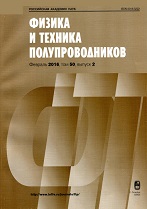|
This article is cited in 2 scientific papers (total in 2 papers)
Manufacturing, processing, testing of materials and structures
Electrical and optical characteristics of Si nanoparticle films deposited on the substrates by high-voltage electrospray casting from ethanol sols
N. N. Kononova, D. V. Davydovab, S. S. Bubenovb, S. G. Dorofeevb
a Prokhorov General Physics Institute of the Russian Academy of Sciences, Moscow
b Lomonosov Moscow State University, Faculty of Chemistry
Abstract:
The paper describes the results of studying the optical and electrical characteristics of films made of silicon nanoparticles ($nc$-Si) deposited on substrates by high-voltage electrospray from sols of $nc$-Si in ethanol. It was found that the interaction of ethanol droplets carrying $nc$-Si with an electric field of corona discharge leads to polymerization of ethanol and formation of a polymer layer on the nanoparticle surface. The geometry and electric field strength in the flow area of ethanol droplets could be changed by means of the focusing electrode in the high-voltage device. As a result we could make $nc$-Si films with different kind of polymer layer on Si nanoparicle surface: $nc$-Si_A and $nc$-Si_B (the films deposited without and with focusing electrode, respectively). The optical band gap $E_g$ of $nc$-Si_A films increased from $\sim$1.9 to $\sim$2.2 eV after annealing at the temperatures from room one to 400$^\circ$C in air atmosphere. The $E_g$ of the $nc$-Si_B films was independent on annealing and was 1.85 eV. The constancy of $E_g$ in $nc$-Si_B films is explained by the polymer properties on the Si nanoparticles surface in these films and more effective blocking the penetration of oxygen atoms from the surrounding atmosphere during annealing to temperatures of 400$^\circ$C than in the case of the polymer in $nc$-Si_A films. The temperature dependences of the conductivity (dark and photo) of $nc$-Si_A films are approximated with good accuracy by two exponential functions, the dark activation energies of the films being approximately equal to 0.75 and 0.1 eV. The conductivity of $nc$-Si_A films decreased noticeably when illuminated with radiation in the range 460–470 nm The temperature dependences of the conductivity of $nc$-Si_B films with good accuracy is approximated by one-exponential function of the activation type with activation energies of 0.73 (dark) and 0.59 eV (photo). In contrast to the $nc$-Si_A films, the photoconductivity of $nc$-Si_B films increase by more than 4 $\times$ with respect to the dark conductivity when the films were illuminated anologically. The $nc$-Si_B films are photoactive, since sandwich-like structures of Al/$nc$-Si_B/Al can generate emf. The dark and photo-conductivity of $nc$-Si_A films in the voltage range of $V> 2V$ is determined by the two-center Poole–Frenkel effect, the concentration of the centers that determine the character of the Poole–Frenkel conductivity was 3 $\times$ 10$^{17}$ cm$^{-3}$. In $nc$-Si_B films in the voltage range 2–5V, the electronic transport is determined by space-charge-limited currents (SCLC) and at higher voltages by the two-center Pool–Frenkel conduction. The concentration of traps contributing to SCLC in the films is $\sim$4 $\times$ 10$^{16}$ cm$^{-3}$. The concentration of the Pool–Frenkel centers, decreases from 3 $\times$ 10$^{16}$ to 2 $\times$ 10$^{14}$ cm$^{-3}$ with decreasing temperature in the range 120–40$^\circ$C according to the activation law with an activation energy of 0.7 eV.
Received: 25.09.2018
Revised: 29.09.2018
Accepted: 01.10.2018
Citation:
N. N. Kononov, D. V. Davydova, S. S. Bubenov, S. G. Dorofeev, “Electrical and optical characteristics of Si nanoparticle films deposited on the substrates by high-voltage electrospray casting from ethanol sols”, Fizika i Tekhnika Poluprovodnikov, 53:4 (2019), 562–575; Semiconductors, 53:4 (2019), 552–565
Linking options:
https://www.mathnet.ru/eng/phts5552 https://www.mathnet.ru/eng/phts/v53/i4/p562
|


| Statistics & downloads: |
| Abstract page: | 36 | | Full-text PDF : | 15 |
|





 Contact us:
Contact us: Terms of Use
Terms of Use
 Registration to the website
Registration to the website Logotypes
Logotypes








 Citation in format
Citation in format 
